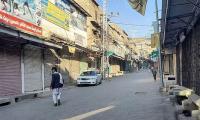PESHAWAR: A research-based book exploring the economic, political and social status of the Sikh population in the provincial capital has been published.
The author Naheed Hussain is an assistant professor at the Government Frontier College for Women in Peshawar. Hailing from the Qandeel village in the Swat district of Khyber Pakhtunkhwa, she has done her Masters of Philosophy (M Phil) from the Pakistan Study Centre, University of Peshawar. The book is based on the research she had undertaken for her MPhil thesis.
The 200-page publication, “A journey into the life world of the Sikh community in Peshawar” has been published by the Iqbal International Institute for Research and Dialogue (IRD), which is a constituent unit of the International Islamic University in Islamabad.
The book is divided into five parts, shedding light on various aspects of the life of the Sikh community, which is estimated to be 8,000 forming 650 families.
The author has dedicated the book to her parents, Syed Sardar Hussain and Bibi Khana, late brother Syed Naveed Hussain and grandfather Syed Mian Gul Farosh. She has acknowledged the IRD Executive Director Dr Husnul Amin, Pakistan Study Centre, University of Peshawar, Director, Prof Dr Fakhrul Islam, other academicians and members of the Sikh community for the help they extended to her while doing research for her book.
The first chapter of the book gives the historical account of the Sikhs in Peshawar. The Sikhs captured Peshawar in 1818, annexed it in 1834 AD and ruled it till the British wrested it from them in 1849.
This portion of the book explains how the Sikhs gained political power and expanded the boundaries of the Lahore Darbar from Kashmir up to the Khyber Pass.
It mentions the Tehreek-e-Mujahideen launched by Syed Ahmad Shaheed (November 29, 1787 - May 6, 1831) that fought the Sikh Raj. The chapter has details on the fall of Peshawar to the Sikh Army and the subsequent rule by Governor Hari Singh Nalwa and later General Paolo Crescenzo Martino Avitabile.
The second part is about the Sikh rituals and festivals. These are Nam Karan (naming of the child at birth), Amrit Sanskar (passing through the process of initiation after embracing the Sikh faith and wearing of five articles of faith called Rehat or 5 Ks. These are Kesh (uncut hair), Kanga (wooden comb), Karha (steel bracelet), Kachha (underwear or shorts) and Kirpan (sword), engagement, marriage (Anand Kartaj), death/funeral (Antam Sanskar), and festivals such as Vaisakhi.
The third section of the book focuses on the economic status of the Sikh community in Peshawar by presenting data. The author concludes that the Sikh community has stable economic status as 84.4 percent are doing business.
The fourth chapter focuses on the political status of Sikhs in Peshawar. The statistical analysis says 76.8 percent Sikhs in Peshawar are aware of their rights, 81.6 percent have information about their representatives and 80.6 percent are registered voters.
The fifth chapter relates to the social status of the community. The author says there is harmony among the Sikh and other communities living in Peshawar including Muslims, Hindus and Christians. She writes that Sikhs take part in functions of other communities and their gesture is reciprocated. She adds that they enjoy a high level of freedom of worship and feel no discrimination at workplaces, health and education sectors.
The book has 41 colourful pictures. These include the historic Gurdwara Bhai Joga Singh Sahib in Peshawar’s Dabgari locality. This well-maintained Sikh temple is known for interior beauty and was declared part of the heritage a decade ago.
PTI maintain leading position in NA elections, with narrow lead of one percentage point over PMLN
Nationalists say province's resources, land, and water were being sold under guise of development







